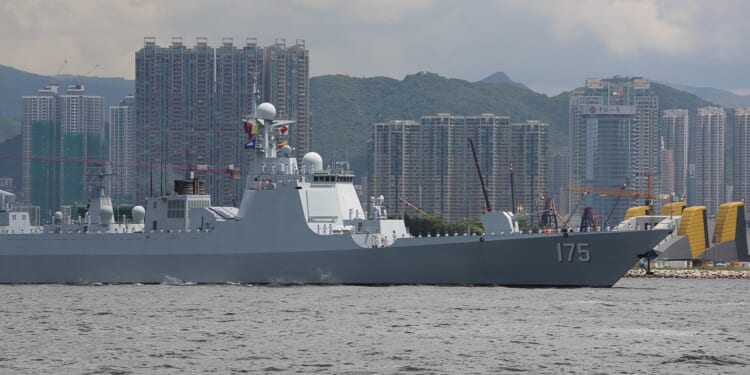A mysterious trimaran-hulled ship under construction at China’s Guangzhou shipyard appears most likely to be an enormous naval drone.
Huangpu Shipyard in Guangzhou, China, is home to a strange-looking vessel that was first picked up on overhead satellites. That vessel is around 65 meters long and is currently under construction. The vessel looks like something from a science fiction film. It has a trimaran hull form—one main hull plus two outriggers—and it is possibly semi-submersible rather than a conventional surface ship.
This new Chinese ship has a long and slender hull, with a tall superstructure, and the worksite has been unusually covered in tarpaulins, according to the trade publication, Defence Blog. Additionally, it is believed that the vessel is unmanned or minimally crewed, given the limited space for traditional crew accommodations and the minimalist superstructure.
What Kind of Ship Is China Building?
One supposition is that this is an unmanned arsenal ship; a missile carrier that has a large number of vertical launch system (VLS) cells for long-range cruise missiles or similar weapons. If that is the case, then, this vessel may rely on external targeting/datalinks rather than its own larger radar/sensor suite.
While none of this has been confirmed, multiple reputable defense publications—including Naval News—have reported on this story. And it is in keeping with overall Chinese strategic doctrine.
For instance, China has been keen on developing swarming capabilities that can overwhelm the defenses of warships belonging to the United States Navy. By having a missile-carrying vessel that is smaller and, therefore harder, to detect—a potentially autonomous vessel—China could significantly increase the number of strike nodes dispersed across the sea.
Sadly, the Americans are not prepared for this possibility. And even if the Pentagon was prepared for it, there has been little in the way of developing counter drone systems by the US Navy. So, manned US warships would be highly susceptible to the kind of attacks these floating magazine unmanned platforms could pose to the Navy.
The PLAN Is Pouring Its Resources Into Naval Drones
Given the available information at some of the world’s top defense publications, along with what is already known about Chinese investments in maritime drones—as well as their commitment to building out strike capabilities across a variety of domains—it is likely that Beijing is building an experimental vessel with the trimaran, semi-submersible features described in multiple essays. It is, quite frankly, a stealthy missile carriage—and once it is complete, it will be a real problem for Uncle Sam.
While this is likely a proof of concept for China, the People’s Liberation Army Navy (PLAN) is leaning heavily toward these systems. And that’s because they must prevent the United States Navy from deploying in regions that Beijing’s forces covet (notably Taiwan, but also in places like the South and East China Seas). These unmanned missile platforms will be key to stunting the US Navy’s power projection into these contested regions.
About the Author: Brandon J. Weichert
Brandon J. Weichert is a senior national security editor at The National Interest. Recently, Weichert became the host of The National Security Hour on America Outloud News and iHeartRadio, where he discusses national security policy every Wednesday at 8pm Eastern. He is also a contributor at Popular Mechanics and has consulted regularly with various government institutions and private organizations on geopolitical issues. Weichert’s writings have appeared in multiple publications, including The Washington Times, National Review, The American Spectator, MSN, and the Asia Times. His books include Winning Space: How America Remains a Superpower, Biohacked: China’s Race to Control Life, and The Shadow War: Iran’s Quest for Supremacy. His newest book, A Disaster of Our Own Making: How the West Lost Ukraine is available for purchase wherever books are sold. He can be followed via Twitter @WeTheBrandon.
Image: Shutterstock / YIUCHEUNG.

















